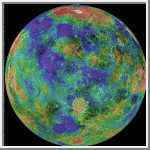

Hemispheric View of Venus
This hemispheric view of Venus, as revealed by more than a decade of radar investigations culminating in the 1990-1994 Magellan mission, is centered at 0 degrees east longitude. The effective resolution of this image is about 3 kilometers. It was processed to improve contrast and to emphasize small features, and was color-coded to represent elevation
Venus, the jewel of the sky, was once know by ancient astronomers as the morning star and evening star. Early astronomers once thought Venus to be two separate bodies. Venus, which is named after the Roman goddess of love and beauty, is veiled by thick swirling cloud cover.
Astronomers refer to Venus as Earth's sister planet. Both are similar in size, mass, density and volume. Both formed about the same time and condensed out of the same nebula. However, during the last few years scientists have found that the kinship ends here. Venus is very different from the Earth. It has no oceans and is surrounded by a heavy atmosphere composed mainly of carbon dioxide with virtually no water vapor. Its clouds are composed of sulfuric acid droplets. At the surface, the atmospheric pressure is 92 times that of the Earth's at sea-level.
From www.solarviews.com
Back to Home